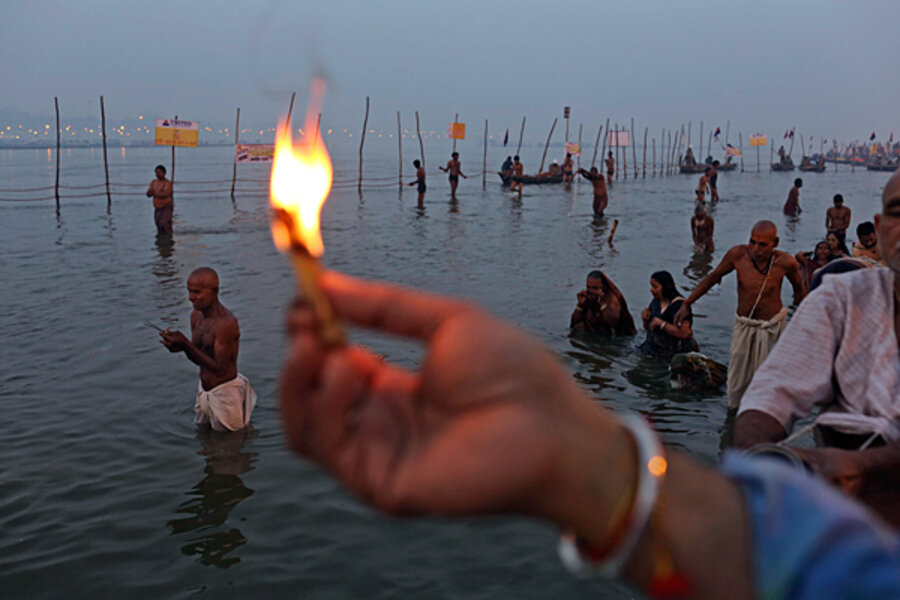Kumbh Mela: A million man dip
Loading...
| New Delhi
This week, Hindu ascetics in ostentatious chariots pulled by elephants and horses along with pilgrims and tourists from around the world arrived in Allahabad, about halfway between New Delhi and Kolkata, India.
Their faces smeared with ash and bodies covered in little more than marigold garlands, the religious men marked the opening of the Kumbh Mela, by rushing into the cold water to bathe at 5 a.m. on Monday.
The Hindu festival is billed as the world's largest gathering, a chance to wash away karmic debt and liberate oneself from the cycle of rebirth and death. It's also a broadly shared experience in a country where the saying goes that there are as many Indias as there are Indians.
"What is most endearing about the Kumbh festival is that all Hindus across caste and class come together. All hierarchies melt in the great river. It's unity in diversity," says Ram Naresh Tripathi, a retired journalist and Hindu astrologer in Allahabad.
This is one of four Kumbh Melas, each held in different cities over different intervals – this one comes to Allahabad every 12 years. These festivals are all miraculous, at the very least in terms of logistics.
On Monday's opening, at least 10 million people bathed in the sangam, or confluence, of three rivers, the Ganga, the Yamuna, and the Saraswati. By the end of the festival on March 10, an estimated 100 million people will have bathed in the river. Feb. 10 is the day considered most auspicious by religious followers, and is therefore the busiest day.
A temporary tent city has been set up on 6,000 acres of land, and the Indian Railways is running 750 special trains to make sure people from different parts of the country can reach it.
The numbers indicate the scale of the exercise: 18 pontoon bridges, 35,000 toilets, 97 miles of new roads, 355 miles of water pipelines, 497 miles of electric wires, 48 power sub-stations, four warehouses for grains, groceries and vegetables, 22 doctors, 120 ambulances, 30 new police stations, 100 beds for local hospitals and so on, according to Mela Officer Mani Prasad Mishra.
At a press conference addressed, journalists complained about incomplete work, to which Mr. Mishra replied that the authorities had been rushing against time. "We are in control of the situation and whatever requirements are needed to conduct it successfully have been put in place," he said.
The government has taken measures to fight contagious diseases, expected stampedes and fires, and terrorist attacks. Some 30,000 policemen are patrolling the Kumbh, which is under the surveillance of 56 watchtowers and 89 CCTV cameras. A market made up of 11,000 stalls has been set up to sell everything from food to ornaments and curios.
The festival cost an estimated $290 million to organize, but a study by The Association of Chambers of Commerce and Industry in India says the Uttar Pradesh state government is likely to recover most of it through revenues generated by tourism.
Tourists and pilgrims are expected from across the world. Among the expected visitors: The Tibetan spiritual leader the Dalai Lama, and actors Richard Gere, Michael Douglas, and his wife Catherine Zeta Jones.
Mr. Tripathi, the journalist-turned-astrologer, said the Kumbh had changed a lot since his childhood, with the gathering now catering to Hindus with newfound wealth. “The sadhus [ascetics] have all become hi-tech. They used to come on foot from hundreds of miles away but today they come in cars and carry gadgets like tablet computers,” he says.






